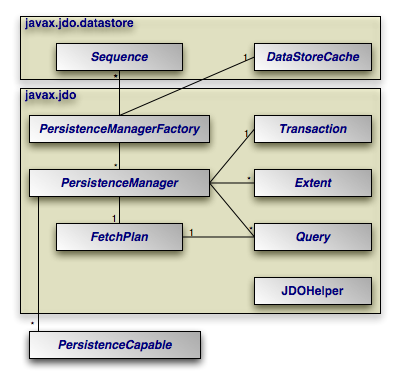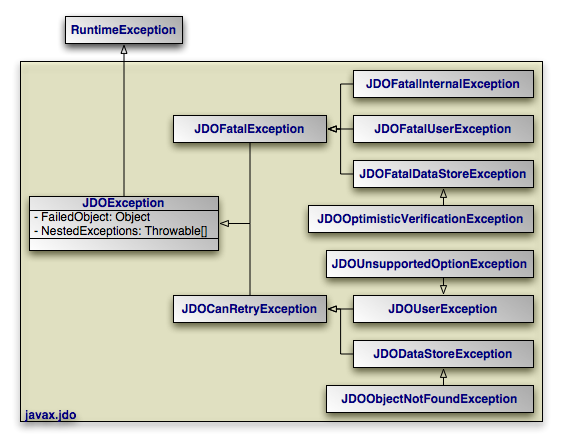The diagram below illustrates the relationships between the primary components of the JDO architecture.

JDOHelper: Thejavax.jdo.JDOHelpercontains static helper methods to query the lifecycle state of persistent objects and to obtainPersistenceManagerFactoryinstances in a vendor-neutral fashion.PersistenceManagerFactory: Thejavax.jdo.PersistenceManagerFactoryis a factory forPersistenceManagers.PersistenceManager: Thejavax.jdo.PersistenceManageris the primary JDO interface used by applications. EachPersistenceManagermanages a set of persistent objects, and has APIs to insert new objects and delete existing ones. There is a one-to-one relationship between aPersistenceManagerand aTransaction.PersistenceManagers also act as factories forExtentandQueryinstances.PersistenceCapable: JDO calls user-defined persistent classes persistence-capable classes. Most JDO vendors provide an enhancer to transparently add a specialPersistenceCapableinterface to each persistent class. You will never use this interface directly.Transaction: EachPersistenceManagerhas a one-to-one relation with a singlejavax.jdo.Transaction.Transactions allow operations on persistent data to be grouped into units of work that either completely succeed or completely fail, leaving the datastore in its original state. These all-or-nothing operations are important for maintaining data integrity.Extent: Ajavax.jdo.Extentis a logical view of all the objects of a particular class that exist in the datastore. You can configureExtents to also include subclasses.Extents are obtained from aPersistenceManager.Query: Thejavax.jdo.Queryinterface is implemented by each JDO vendor to find persistent objects that meet certain criteria. JDO standardizes support for queries using the Java Data Objects Query Language (JDOQL), and for relational database queries using the Structured Query Language (SQL). You obtainQueryinstances from aPersistenceManager.FetchPlan: EachPersistenceManagerandQueryhas a mutable reference to ajavax.jdo.FetchPlan. TheFetchPlangives you control over eager fetching, result scrolling, and other data loading behavior.Sequence: Thejavax.jdo.datastore.Sequenceinterface represents an object capable of generating sequential values. Sequences are defined in mapping metadata (see Chapter 15, Mapping Metadata), cached at thePersistenceManagerFactorylevel, and obtained through thePersistenceManager.DataStoreCache: Many JDO implementations provide some form of datastore cache. Thejavax.jdo.datastore.DataStoreCacheinterface provides a standard way to interact with your vendor's cache.
The example below illustrates how the JDO interfaces interact to execute a JDOQL query and update persistent objects.
Example 3.1. Interaction of JDO Interfaces
// get a PersistenceManagerFactory using the JDOHelper; typically
// the factory is cached for easy repeated use
PersistenceManagerFactory factory =
JDOHelper.getPersistenceManagerFactory (System.getProperties ());
// get a PersistenceManager from the factory
PersistenceManager pm = factory.getPersistenceManager ();
// updates take place within transactions
Transaction tx = pm.currentTransaction ();
tx.begin ();
// query for all employees who work in our research division
// and put in over 40 hours a week average
Extent extent = pm.getExtent (Employee.class, false);
Query query = pm.newQuery (extent);
query.setFilter ("division.name == 'Research' && avgHours > 40");
// we only need to populate the metadata-defined salary fetch group data;
// there might be a lot of employees, so read from store in batches of 100
query.getFetchPlan ().setGroup ("salary");
query.getFetchPlan ().setFetchSize (100);
List results = (List) query.execute ();
// give all those hard-working employees a raise; keep track of hardest worker
Employee emp;
Employee mostHours = null;
for (Iterator itr = results.iterator (); itr.hasNext ();)
{
emp = (Employee) itr.next ();
emp.setSalary (emp.getSalary () * 1.1);
if (mostHours == null || emp.avgHours () > mostHours.avgHours ())
mostHours = emp;
}
// we know we're going to be fetching the hardest-working employee a
// lot in our application, so pin its data to the cache
factory.getDataStoreCache ().pin (JDOHelper.getObjectId (mostHours));
// commit the updates and free persistence manager
tx.commit ();
pm.close ();
// if we were ending our application, we'd free the factory too
// factory.close ();
The remainder of this document explores the JDO interfaces in detail. We present them in roughly the order that you will use them as you develop your application.

The diagram above depicts the JDO exception architecture. Runtime
exceptions such as NullPointerExceptions and
IllegalArgumentExceptions aside, JDO
components only throw
JDOExceptions.
The JDO exception hierarchy should be self-explanatory. The base
JDOException class provides the following useful
properties:
FailedObject: The failed object is the persistent instance or identity object that caused the exception, if applicable. It is particularly useful forJDOOptimisticVerificationExceptions andJDOObjectNotFoundExceptions.NestedExceptions: An array of nested exceptions that caused the failure. Rather than stop immediately at the first error, many JDO methods collect all errors during execution and throw a single parent exception, nesting the collected exceptions within it. For example, a failed attempt to commit a transaction might result in aJDOFatalDataStoreExceptionwith a nestedJDOOptimisticVerificationExceptionfor each persistent instance that failed the optimsitic concurrency check.
See the Javadoc for additional details on JDO exceptions.